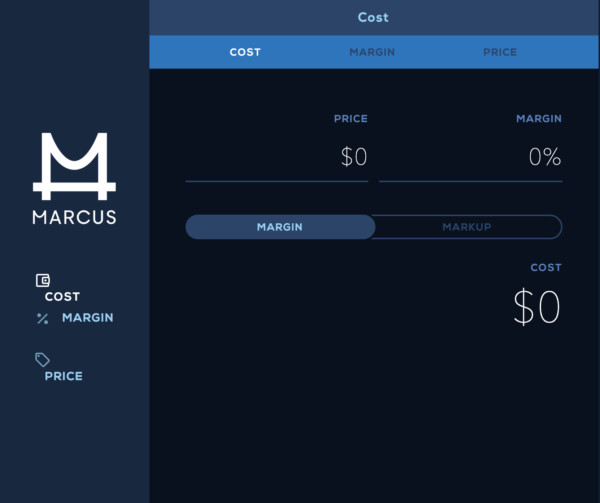
Launching a new product can give your business a boost, taking it to the next level of sales and profitability. Think about how the iPhone was a game-changer for Apple, as well as its biggest technology competitors, or how Tesla’s electric vehicles transformed the automotive market. As Marcus Lemonis says, “If you don’t evolve, you will die.”
While consumers like to see new products in their favorite online and retail stores, there is no guarantee of success. Unless you do your homework, a new product launch strategy has a high risk of failure.
In fact, a study by the Marketing Research Association found that only 40 percent of developed products ever made it to the marketplace, and only about 60 percent of those products generated any revenue.
Marcus has had some experience with launching new products. He recently helped a Los Angeles startup company launch a new line of fashionable smartphone cases. That included conducting preliminary market research to be sure the product line would be perceived as an exciting new addition to a leading mobile device company’s retail stores. Under his guidance, the company was able to close a big sale and take a giant step toward financial success.
Knowing how to launch a new product is vital to achieving your desired results, whether you serve consumers (B2C) or other businesses (B2B). As Marcus says, your product should be “practical, purposeful and profitable.”

Before Launching a New Product
A new product launch strategy requires careful thinking for a restaurant, online retailer, manufacturer or any other type of business. There is no point in investing your time and money in a new product if there is insufficient demand in your marketplace. Creating the wrong product is one of the largest reasons for failure.
Clearly, market research is essential when considering how to launch a new product. You need to learn as much as you can about your target market while designing and developing a new product.
For instance, you could conduct a survey of your current customers to see if they might be interested in a new offering. You could also gather information about prospects who might not be aware of your business and product line. That step is particularly important if your new product launch strategy involves entering a brand-new market.
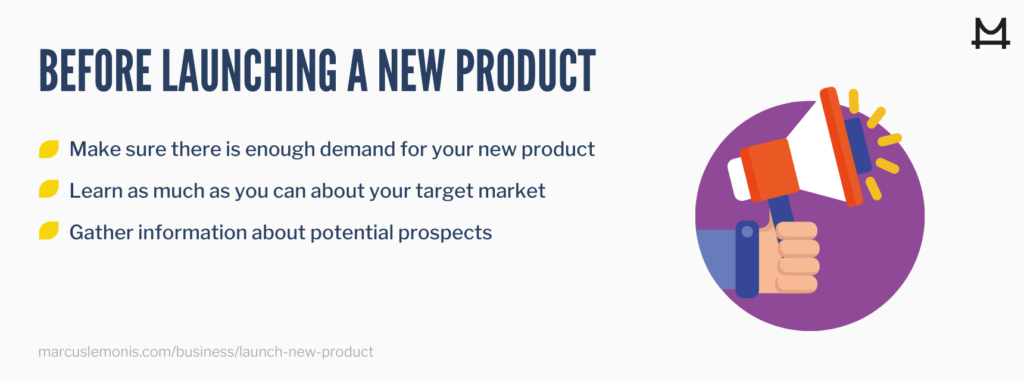
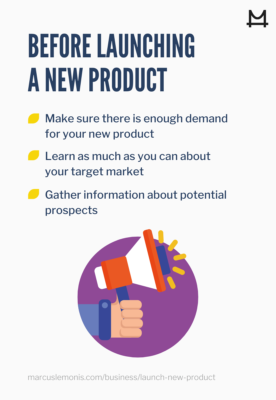

Survey the Competition
Your market research should include surveying the competition. Are they offering similar products to consumers or B2B customers? Are there points of vulnerability that would allow your new product to gain traction in the market? For instance, can your new product offer more features and benefits, a lower price or greater convenience to prospects?
You should also think about indirect competition, since that can affect an entire product category.
If you are launching a new type of roller blades, for example, your prospects may also be tempted to spend their time skateboarding, bicycling or jogging. You could wind up with the best line of roller blades in history, only to have customers choose an alternative recreational activity. Of course, you could then use that expertise to launch a new line of skateboards!
Know Your Numbers
The next step in how to market a new product is a careful analysis of the requirements for bringing your new product to market.
- What is the potential revenue that could be generated by the new product?
- How quickly will that revenue start coming into the business?
- What are the estimated costs for designing, developing, prototyping and finalizing the new product?
- What is the projected profitability of the new product?
- What quantities of the new product will be needed during the initial rollout and afterwards, if all goes well?
- Will more people need to be hired or engaged to sell the new product?
- Will the website require a substantial redesign or addition to incorporate the new product?
Use those initial projections to build a financial pro forma, highlighting how the new product launch strategy will benefit your company. But if the projected costs are too high, you should scale back your plans, find a way to reduce expenses, or change your plans, perhaps turning your attention to a different product. Being willing to make adjustments is always important when considering how to launch a new product.
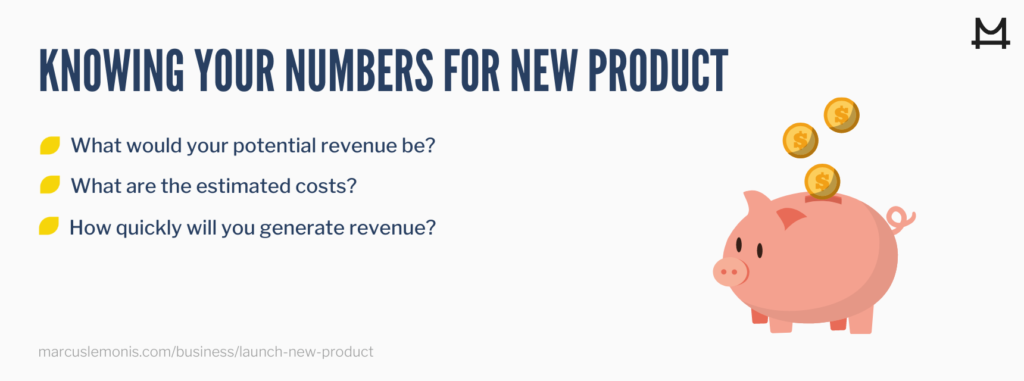
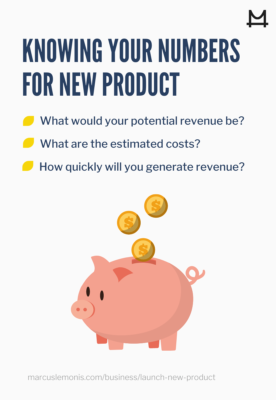
If you do decide to go ahead, you should set some clear and measurable goals for your new product. How many units do you expect to sell in the first month, quarter and year? If the new product is a success, what could sales look like in two or three years? Setting goals is like focusing on your destination when driving a vehicle. It will help you chart your progress and overcome any roadblocks or detours along the way. As Marcus says, “Stay focused, work hard, know your numbers, and be disciplined.”

Pitch To Your Stakeholders
Assuming the financial projections support a new product launch, the next step is to pitch your new product launch strategy to your stakeholders. Prepare a positioning statement that explains your new product and where it fits into your current lineup. You should identify the target market for your new product, and how your offering will be different from the competition.
Use that information to bring your business partners and investors up to speed on your plans. But don’t rush out to tell everyone in your organization right away, since you will still need some time to develop your new product and bring it to market. The last thing you want to see is a social media post from a friend of an employee that provides a detailed look at your new product launch strategy. That would give your competitors time to counter your strategy – even before your new product is available!

Begin Your New Product Launch Strategy
Now, it’s time to see if all that preliminary work will pay off – just as it did for the co-owners of a barbecue restaurant in Kentucky who were wondering how to launch a new product. With Marcus’ help, they developed a line of barbecue sauces using their proprietary recipes. By selling the bottled sauces online and at their restaurant, they were able to generate a robust stream of new revenue for their business.
If you are thinking about how to launch a new product, here are several important steps in a successful new product launch strategy.

- Plan your launch. A new product launch is a big step for any business, so plan accordingly. Determine your marketing program and timetable, and be sure to set aside adequate resources to support your launch. This might include adding support personnel to field a higher volume of incoming calls, texts or emails, as well as training your employees to answer questions about the new product.
- Test the plan. Try to walk through the initial phases of your new product launch strategy before it happens in real time.
This will allow you to identify any problems that may pop up during the launch, so you will be better prepared to deal with things going wrong.

- Generate excitement. Prepare a marketing campaign to get your target audience excited about your new product. That could involve a teaser campaign on social media, a simple email message to business executives or a direct mail postcard to households in your local market. Use your creativity and stay focused on the benefits of your new product.
- Capture early leads. You could create a new landing page on your website, or a form for prospects interested in the new product.
Social media sites also offer numerous opportunities for capturing leads from potential customers who want to opt-in to your messaging.

- Check your assumptions. Keep track of the response to your marketing campaign. Are you starting to get inquiries about the new product? Are more prospects visiting your website? If so, then your new product launch strategy may be paying off. If not, then you need to revisit your strategy or consider making changes to your new product.
- Be ready to pivot. If your product launch isn’t going as planned, be ready to pivot. Perhaps you need to shift your marketing efforts to another channel, or focus on a different demographic group.
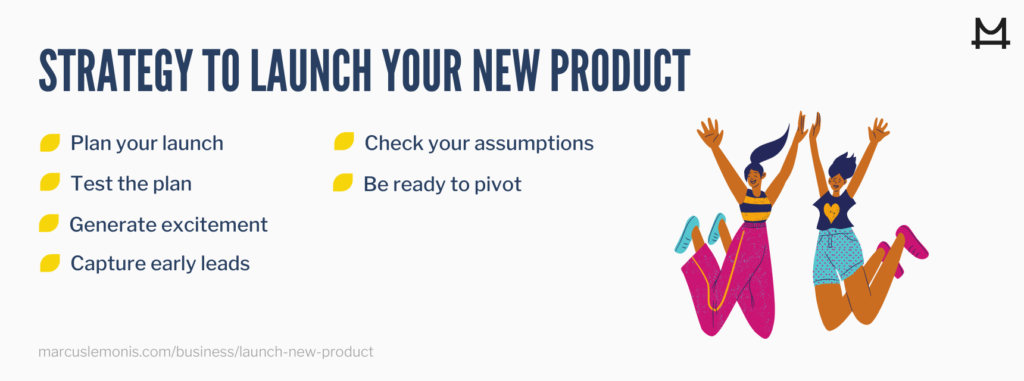
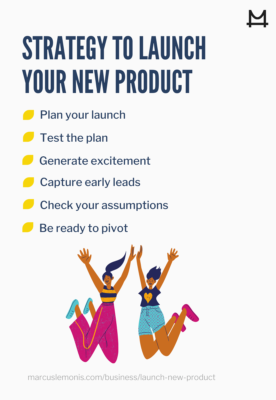
Finally, you should also be prepared for better than expected success. If sales of your new product take off, you may have to increase your production or order a greater volume from your supplier. You might also need to hire more sales and support personnel in order to ensure high quality customer service. But these are usually good issues to tackle, as it means that your new product – as well as your entire brand – are moving ahead in your market. As Marcus says, “In any business, you can’t be complacent. If you do, you’re going to go backwards.”
- How do you prepare your team for a new product launch?
- How do you build excitement about a new product?
Drake, A. (2019, October 10). The product launch: 31 statistics to keep in mind.Retrieved from https://learn.g2.com/product-launch-statistics

